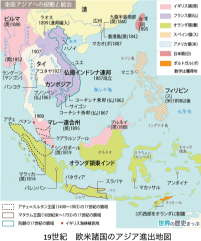
日本の欧米列強国との不平等条約の改正
治外法権の撤廃 →アジア大陸への進出
19世紀は、欧米諸国の帝国主義によるアジア諸国への
侵略の歴史であり、中国をはじめ、日本とイを除くア
ジア諸国は、イギリス、オランダ、アメリカ、フランスなど
により、ほぼ植民地化されていた。
日本は、1868年に明治時代となり、植民地化を排撃す
るため、富国強兵政策をとった。しかし、江戸時代に諸
外国と徳川幕府の間に締結された一方的な関税自主
権や片務的な治外法権などの「不平等条約」に縛られ
ていた。
1894年(明治27)、日本は、イギリスと締結した「日英
和親条約」の改正に成功したことを始めに、アメリカや
オランダフランスなどの諸外国との不平等条約を次々
と改正した。
日本は明治4年に迅速に郵便制度を発足させ、欧米に
よる通信支配の排斥に成功した。これは、日本が欧米
諸国による不平等条約下にありながらも、他のアジア
諸国とは異なり、植民地や被侵略地とならなかったこと
の歴史的功績のひとつである。
Amendment of unequal treaty between Japan and Western countries and abolition of extraterritoriality → Japan’s advance into the Asian continent
The 19th century was the history of the imperialism of Western countries invading Asian countries,
and Asian countries other than Japan and Thailand, including China, were almost colonized by the
United Kingdom, the Netherlands, the United States, France, and so on. .. In the Meiji era in 1868,
Japan adopted a wealthy military policy to eliminate colonization. However, it was bound by
“unequal treaties” such as one-sided tariff autonomy and one-sided extraterritoriality signed
between foreign countries and the Tokugawa Shogunate during the Edo period. In 1894 (Meiji 27),
Japan succeeded in amending the Anglo-Japanese Friendship Treaty with the United Kingdom,
and then entered into unequal treaties with other countries such as the United States and the
Netherlands and France.Was revised. Japan swiftly launched a postal system in the 4th year of
Meiji, and moved to Europe and the United States.Succeeded in excluding communication
control by. This is one of the historical achievements that Japan, unlike other Asian countries, did
not become a colony or an invaded area, even though it was under an unequal treaty by Western
countries.
日清戦争と日露戦争 第一次世界大戦 → 日本のアジア諸国への覇権
1895年(明治28)に日本は日清戦争に勝利した。それ以降、日本は中国の実質的支配下に置かれていた朝鮮に軍を駐留させ、民間人による現地での経済活動を促進させた。その頃から日本は朝鮮半島経由で中国本土の一部にも進出していた。そうした中、1995年に併合した台湾、軍を派遣した支那東北部、朝鮮半島における軍民活動で、政府間、政府と軍、民間同士の通信は非常に重要な役割を演じていた。当時、現地の通信手段は専ら封書(手紙)によるものだったので、逓信省は日本切手をそれら地域で現地通信及び日本と諸外国の通信にに使用させた。これは、19世紀半ばに、欧米諸国が日本に開港させた港に通信基地(郵便局や領事館)を設立して、彼ら独自の通信網を確立したことに酷似している。言い換えれば、欧米諸国のアジア覇権と同じく、日本が中国や朝鮮に進出し、ロシアの南下政策に対抗するための軍事的活動や、日本の国益のための経済活動を推進したことの痕跡である。 (詳細は各切手解説文参照)
日清戦争から10年後の1904年(明治37)に、南下政策による中国北東部への進出を遂行するロシアと、それを阻止しようとする日本(実際はイギリスが日本を支援)の間で日露戦争が勃発し、日本が勝利した。この戦争は、陸部では中国が主戦場となった。この時期に日本の通信に使用された切手は、「支那」字を加刷した菊切手(「支那字入菊切手」参照)だった。この加刷切手は、中国本土での日本通貨流通が困難だったため、1922年(大正11)まで使用された。
1914年(大正3)、第一次世界大戦に日本も参戦した。日本はドイツに宣戦布告し、中国山東半島の青島に上陸し、ドイツ軍を1917年(大正6)に降伏させた。この時も田沢型切手に「軍事」加刷した切手が将兵に配賦された。この時のドイツ将兵は俘虜となり、四国にある坂東収容所などに1920年迄収容された。1917年には、ロシア帝国が崩壊し、ソビエト連邦が誕生した。第一次世界大戦の勝利により、日本は国際連盟の常任理事国となり、南洋諸島の信託統治権を得た。
Sino-Japanese War and Russo-Japanese War World War I
→ Japan’s hegemony over Asian countries
In 1895 (Meiji 28), Japan won the Sino-Japanese War. Since then, Japan has stationed troops in Korea, which was under substantial control of China, and promoted local economic activities by civilians. From that time on, Japan had expanded into parts of mainland China via the Korean Peninsula. Under such circumstances, intergovernmental, government-to-military, and civilian communications played a very important role in military-civilian activities in Taiwan, which was annexed in 1995, northeastern China, where troops were dispatched, and the Korean Peninsula. At that time, the local means of communication was exclusively by letter, so the Ministry of Communications used Japanese stamps for local communication and communication between Japan and other countries in those areas. This is very similar to the establishment of communication bases (post offices and consulates) in the ports opened by Western countries in Japan in the middle of the 19th century, and their own communication networks. In other words, it is a trace of Japan’s advance into China and Korea, as well as the Asian hegemony of Western countries, promoting military activities to counter Russia’s southward policy and economic activities for Japan’s national interest. (Refer to each stamp commentary for details)
In 1904 (Meiji 37), 10 years after the Russo-Japanese War, between Russia, which was pursuing a southward expansion into northeastern China, and Japan, which was trying to prevent it (actually, Britain supported Japan). The Russo-Japanese War broke out and Japan won. In this war, China became the main battlefield in the land. The stamps used for Japanese communications during this period were chrysanthemum stamps with the”Chinese character” printed on them (see “Chrysanthemum stamps with Chinese characters”). This overprint stamp was used until 1922 (Taisho 11) because it was difficult to circulate Japanese currency in mainland China.
In 1914 (Taisho 3), Japan also participated in World War I. Japan declared war on Germany, landed on Qingdao on the Shandong Peninsula of China, and surrendered German troops in 1917 (Taisho 6). At this time as well, stamps with “military” overprints on Tazawa-type stamps were distributed to the generals. At that time, German soldiers became prisoners of war and were detained in Bando camps in Shikoku until 1920. In 1917, the Russian Empire collapsed and the Soviet Union was born. With the victory of World War I, Japan became a permanent member of the League of Nations and gained trusteeship in the South Sea Islands.
